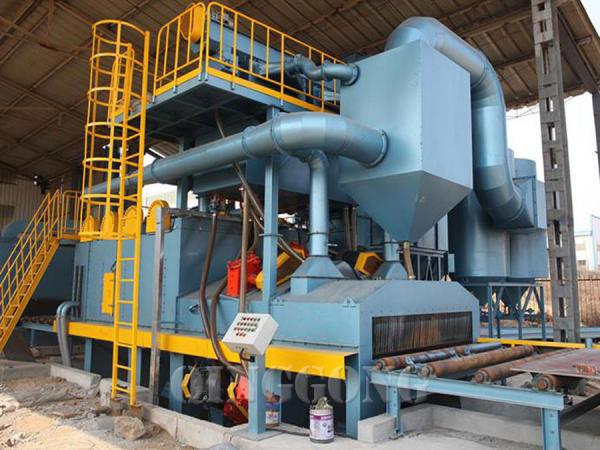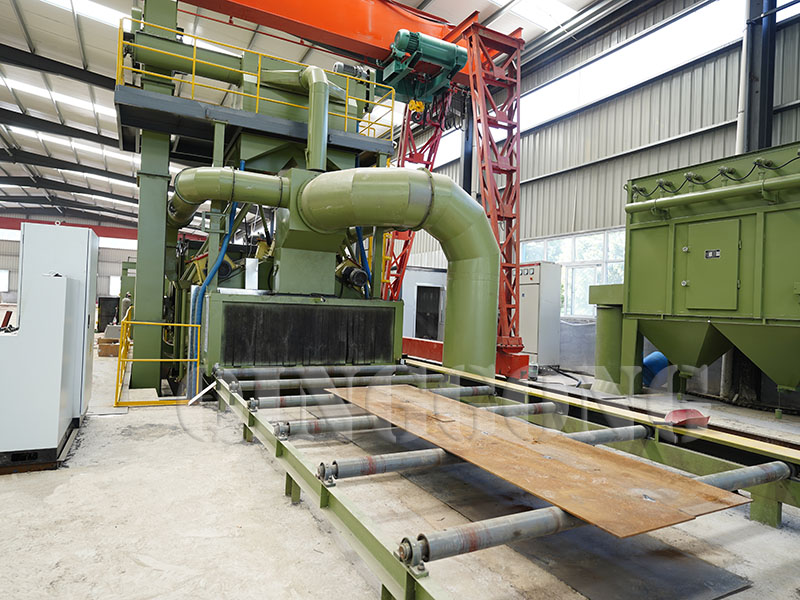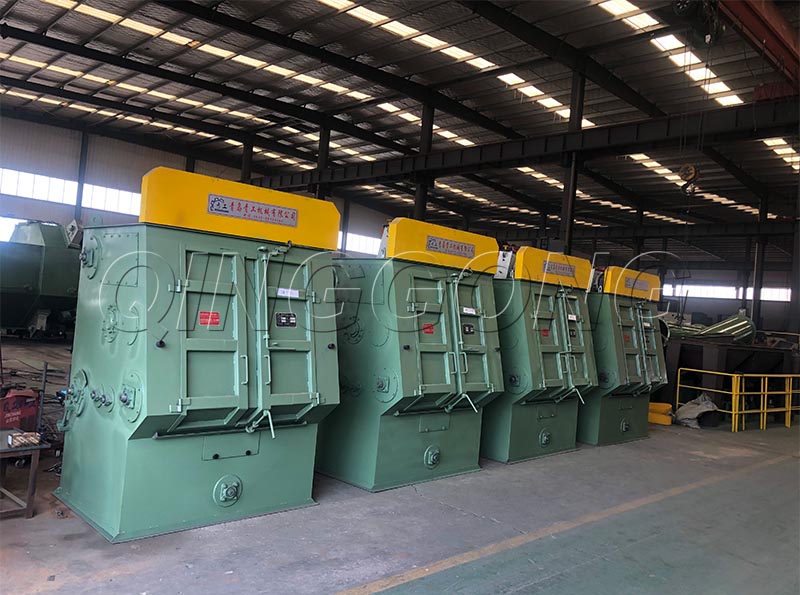Introduction to shot blasting machines: What they are and how they work
Shot blasting machines are industrial equipment used to clean, strengthen, and polish metal surfaces in manufacturing processes. They use a high-speed stream of abrasive materials, such as steel shot or grit, to blast against the surface of the material being treated. This process can remove rust, paint, scale, and other contaminants, as well as improve the surface finish of the material.
The basic design of a shot blasting machine includes a chamber or cabinet where the material to be treated is placed, and a high-speed centrifugal blower or turbine that propels the abrasive material towards the surface of the material. The abrasive material can be recycled and reused in the machine for multiple cycles, which makes the process more environmentally friendly and cost-effective.
Shot blasting machines can be used for a variety of purposes in manufacturing processes, including surface preparation, cleaning, and deburring. They are widely used in industries such as automotive, aerospace, construction, and foundries. With their ability to automate and streamline processes, the shot blasting machine has become an indispensable tool in modern manufacturing.
Benefits of using shot blasting machines in manufacturing processes
Shot blasting machines are widely used in manufacturing processes due to their numerous benefits. Here are some of the main advantages of using shot blasting machines:
Efficient cleaning: Shot blasting machines can efficiently clean surfaces of various materials, including metals, plastics, and composites. The machines use abrasive particles to remove rust, paint, and other contaminants from the surface, leaving a clean and prepared surface for further processing.
Increased productivity: Shot blasting machines are designed to perform high-speed cleaning and surface preparation operations, which can significantly increase the productivity of manufacturing processes. By automating the cleaning process, the machines can save time and reduce labor costs.
Consistent quality: Shot blasting machines can produce consistent results, which is essential for maintaining quality in manufacturing processes. The machines can deliver the same level of surface preparation and cleaning every time, ensuring that the final product meets the required standards.
Improved safety: Shot blasting machines are equipped with safety features that protect the operator and the environment from the hazards associated with abrasive cleaning. The machines are designed to contain the abrasive particles and prevent them from escaping into the surrounding area.
Versatility: Shot blasting machines are available in different sizes and configurations, making them suitable for various manufacturing processes. The machines can be used to clean, polish, and prepare surfaces for painting, coating, or bonding.
Increased productivity with shot blasting machines: How they can save time and labor costs
Shot blasting machines are highly efficient in increasing productivity in various manufacturing processes. Here are some ways in which shot blasting machine can help increase productivity:
Speed: Shot blasting machines are designed to operate at high speeds, which allows them to clean and prepare surfaces quickly. This means that the manufacturing process can be completed faster, which increases productivity.
Automation: Shot blasting machines are automated, which means that they can run continuously without the need for constant supervision. This allows the operator to focus on other tasks, which can also increase productivity.
Consistency: Shot blasting machines produce consistent results, which ensures that the final product meets the required standards every time. This reduces the need for rework, which can save time and increase productivity.
Reduced labor costs: Shot blasting machines require minimal labor to operate, which can reduce labor costs significantly. This allows the manufacturing process to be completed more efficiently and cost-effectively, which increases productivity.
Reduced downtime: Shot blasting machines require minimal downtime for maintenance and repairs, which means that they can operate continuously for longer periods. This reduces the amount of time lost to maintenance, which can increase productivity.
Types of shot blasting machines and their applications in different industries
Shot blasting machines are used in various industries to clean, prepare, or finish a surface by forcibly propelling abrasive materials against it. There are different types of shot blasting machines available, each designed for specific applications in different industries. Here are some of the common types of shot blasting machines and their applications:
Wheel blasting machines: This type of machine is used to clean or peen large, heavy-duty components like steel plates, pipes, and structural elements. The abrasive is propelled by a high-speed rotating wheel, which is located in a blast chamber. This type of machine is commonly used in the automotive, aerospace, and construction industries.
Air blasting machines: Air blasting machines are used to clean, polish, or deburr small to medium-sized components like castings, forgings, and machined parts. The abrasive is propelled by compressed air, which is mixed with the abrasive in a blast gun. This type of machine is commonly used in the metalworking and electronics industries.
Wet blasting machines: Wet blasting machines use a mixture of water and abrasive to clean and prepare surfaces. This type of machine is ideal for delicate surfaces or materials that cannot withstand the impact of dry blasting. Wet blasting machines are commonly used in the aerospace and medical industries.
Tumble blasting machines: Tumble blasting machines are used to clean and deburr small components in batches. The components are placed in a rotating drum, which is filled with abrasive. As the drum rotates, the abrasive removes any burrs or contaminants from the components. This type of machine is commonly used in the jewelry, dental, and electronics industries.
Shot peening machines: Shot peening machines are used to improve the fatigue life of components by inducing compressive stresses on their surfaces. This type of machine is commonly used in the aerospace and automotive industries to improve the durability of critical components like engine parts, gears, and springs.
In summary, shot blasting machines are essential tools for many industries to prepare, clean, or finish surfaces. Choosing the right type of machine depends on the size, shape, and material of the components to be processed, as well as the specific requirements of the application.
Factors to consider when choosing the right shot blasting machine for your manufacturing process
Choosing the right shot blasting machine for your manufacturing process is essential to achieve optimal results. Here are some of the factors you should consider when selecting a shot blasting machine:
Surface material and condition: The type of surface material and its condition will determine the type and intensity of blasting required. For example, softer surfaces may require a gentler abrasive and lower blast pressure, while harder surfaces may require a more aggressive abrasive and higher blast pressure.
Component size and shape: The size and shape of the component will determine the type of machine required, as well as the size and capacity of the machine. Larger components may require a wheel blasting machine, while smaller components may be processed in an air blasting machine or tumble blasting machine.
Production volume: The volume of components to be processed will determine the size and capacity of the machine required. For high-volume production, a larger machine may be necessary to ensure efficient and consistent processing.
Abrasive type and size: The type and size of abrasive will depend on the surface material and condition, as well as the desired finish. Harder abrasives like steel shot or grit may be required for tougher surfaces, while softer abrasives like glass beads may be used for more delicate surfaces.
Machine mobility and flexibility: The mobility and flexibility of the machine may be important depending on the manufacturing process. For example, a machine that can be easily moved or adjusted may be necessary to accommodate different component sizes or shapes.
Environmental considerations: The environmental impact of the blasting process should also be considered. Some blasting methods may produce more dust or noise, which can affect workers and the environment. Choosing a machine with lower emissions or noise levels may be necessary for certain applications.
In summary, choosing the right shot blasting machine requires careful consideration of several factors. By evaluating the surface material, component size, production volume, abrasive type, machine mobility, and environmental impact, you can select a machine that meets your specific manufacturing requirements and delivers the desired results.
 EN
EN
 fr
fr  de
de  es
es  it
it  ru
ru  pt
pt  ar
ar  th
th  pl
pl  ro
ro 


